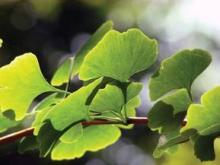In the East, the nut from the inedible fruit of the Ginkgo biloba tree, believed to be the oldest living tree species, has been a popular medical elixir, as well as food item, for many years. People in the West may be most familiar with Ginkgo biloba for the fetid odor of its fruit. During the last 15 years, though, the plant has become well known here for its use as a dietary supplement to treat dementia and memory loss (Arch. Neurol. 1998;55:1409-15; Public Health Nutr. 2000;3:495-9). Ginkgo is also believed to possess properties capable of imparting healthy benefits to human skin.
Medical Uses
In China and Japan, the leaves and nuts of the ginkgo tree have been used for thousands of years to treat various medical conditions, including poor circulation; hypertension; poor memory, dementia, and depression, particularly among the aged; male impotence; and disorders related to an inner-ear imbalance, such as deafness, tinnitus, and vertigo (Hori T, et al. Ginkgo Biloba: A Global Treasure. Berlin, Springer-Verlag, 1997).
Currently, ginkgo is used globally to treat depression, usually in the elderly, and circulatory problems (for example, cerebrovascular and peripheral vascular insufficiency).
G. biloba contains quercetin, which is one of the most abundant natural flavonoids (Clin. Exp. Dermatol. 2001;26:536-9; Free Radic. Biol. Med. 1998;25:196-200). Discussed in a recent column, quercetin is gaining a reputation as a potent antioxidant, conferring significant anti-inflammatory activity. Ginkgo also contains various other flavonoids with demonstrated antioxidant and anti-inflammatory activities against cyclooxygenase (COX) and lipoxygenase (J. Pharm. Pharmacol. 1988;40:787-92; Biochem. Pharmacol. 1993;45:13-9).
It is not surprising, then, that ginkgo is developing a similar reputation as a significant antioxidant and anti-inflammatory agent (Br. J. Dermatol. 2003;149:681-91).
The G. biloba extract EGb 761, prepared from the tree’s leaves, is a natural mixture containing flavone glycosides (33%), mostly quercetin and kaempferol derivatives, and terpenes (6%), that has been used or evaluated for the treatment of stroke, aging, and some adverse drug effects (Biomed. Papers 2003;147:137-45).
This extract has also exhibited the capacity to halt lipoperoxidation by scavenging peroxyl radicals (Photodermatol. Photoimmunol. Photomed. 2002;18:117-20; Pharm. Pharmacol. 1999;51:1435-40; Biochem. Pharmacol. 1995;49:1649-55) and reduce the number of UVB-induced sunburn cells in mice (Photodermatol. Photoimmunol. Photomed. 2002;18:117-20).
In a study of the effects of ginkgetin, a biflavone component of G. biloba leaves reported to confer significant antiarthritic and analgesic activity in rats, ginkgetin down-regulated COX-2 in the dorsal skin of ICR mice treated with 12-O-tetradecanoylphorbol 13-acetate (TPA) and the topical application of both ginkgetin and a mostly 1:1 biflavonoid mixture of ginkgetin and isoginkgetin, from G. biloba leaves, dose-dependently inhibited skin inflammation of croton oil–induced ear edema in mice. Researchers concluded that the capacity of this biflavone constituent of ginkgo leaves to down-regulate COX-2 indicates anti-inflammatory activity against cutaneous inflammation (Planta Med. 2002;68:316-21).
Established in earlier research, the discrete effects of G. biloba extracts such as quercetin and sciadopitysin on UVB-irradiated cultured normal human skin fibroblasts were investigated by researchers using a neutral red dye uptake assay and a lactic dehydrogenase (LDH) release assay. The reduced cytotoxicity observed suggested that the structure-related activity might account for the antioxidant potential of biflavones of G. biloba as well as hydroxy- and methyl-substitutions on the basic structure of these flavonoids (J. Dermatol. 2001;28:193-9).
Anti-Inflammatory and Antioxidant Properties
With the fairly expansive range of applications associated with antioxidant and anti-inflammatory agents, it seems reasonable to expect that ginkgo will join the legion of popular botanical products studied as potential therapies for numerous conditions. In a double-blind placebo-controlled trial in which 47 patients were evaluated, investigators assessed the efficacy of G. biloba extract in controlling limited and slow-spreading vitiligo and promoting repigmentation in affected areas. One group of patients was administered 40 mg G. biloba extract three times daily the other group received the same doses of placebo. Researchers observed a statistically significant cessation of depigmentation in patients treated with G. biloba, with notable to complete repigmentation seen in 10 patients from the treated group, but only two patients in the placebo group. This study lends support to the notion that G. biloba extract may be an effective, safe approach to arresting the progression of vitiligo (Clin. Exp. Dermatol. 2003;28:285-7).
In a study evaluating the effect of orally administered G. biloba extract on UVB-irradiated mouse skin, investigators measured superoxide dismutase (SOD) activity and zinc levels. Zinc, an essential element that acts as a cofactor in some metabolic processes, has reported antioxidant activity and is typically found in high concentrations in the skin. Both SOD activity and zinc levels decreased after UVB exposure in comparison to the control group; after ginkgo treatment, measurement increased, compared with untreated UVB-exposed group (Biol. Trace Elem. Res. 2001;80:175-9). In a previous study, ginkgo extracts exhibited SOD-like activity (Experientia 1989;45:708-12).


